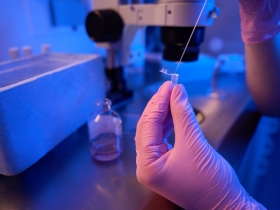Embracing the Future of IVF with Gavi - The Automated Vitrification System
Vitrification: A Revolutionary Technique in Cryopreservation
Vitrification is a state-of-the-art technique for cryopreserving oocytes and embryos at any stage of development. It’s a complex process that demands precision and control over several variables, including temperature, handling of embryos, concentrations of cryoprotectants, and timing. The introduction of automated systems like Gavi has made this process more reliable and efficient. Vitrification has revolutionized cryopreservation by significantly reducing the formation of harmful ice crystals, thereby improving the survival rates of thawed embryos and eggs.

Gavi: The Dawn of Automated Vitrification
Gavi is the world’s first automated vitrification instrument. Developed with embryologists' expertise, It aims to standardize the vitrification process, ensuring it is performed in a controlled, consistent manner every time. (Source: GeneaBiomedx) This level of standardization is crucial in maintaining the viability of the embryos and eggs during the vitrification process. Gavi represents a significant leap forward in assisted reproductive technology, offering a more reliable and efficient approach to embryo and egg vitrification.
The Science Behind Gavi
Gavi employs a robotic liquid-handling unit to dispense the necessary solutions with precision that is challenging to achieve manually. This automation eliminates the need to transfer embryos between different solutions manually. The embryos are housed in a specially designed Gavi pod, which also serves as the embryo storage container during liquid nitrogen (LN2) storage. The Gavi pod is specifically designed to ensure rapid cooling and warming rates, which are critical for the survival of the embryos and eggs. This innovative design ensures that the embryos and eggs are preserved in the best possible conditions. (Source: Merck)
The Advantages of Using Gavi
Gavi offers several advantages over manual vitrification. Firstly, it provides a controlled environment for vitrification, ensuring optimal conditions are achieved every time. Secondly, it reduces the risk of cross contamination as the pod is automatically heat-sealed before being placed directly into LN2. (Source: Hamilton Thorne) This feature is particularly important in maintaining the integrity of the embryos and eggs during storage. Furthermore, Gavi’s automated process reduces the variability associated with manual vitrification, leading to more consistent outcomes. This consistency is key to improving the overall success rates of IVF treatments.
Clinical Outcomes of Gavi
Clinical data from various fertility clinics worldwide have shown that Gavi delivers clinical outcomes comparable to traditional manual vitrification methods. This includes similar rates of embryo survival and clinical pregnancy. These findings underscore the effectiveness of Gavi in improving the success rates of IVF treatments. As we continue to embrace technology in reproductive medicine, tools like Gavi will play a crucial role in improving the success rates of IVF treatments and bringing joy to more families around the world.
Sources:
GeneaBiomedx - Geneabiomedx - products/gavi
Merck - Merckgroup.com/Gavi-How-it-works
Hamilton Thorne - HamiltonThorne - gavi-automated-vitrification






